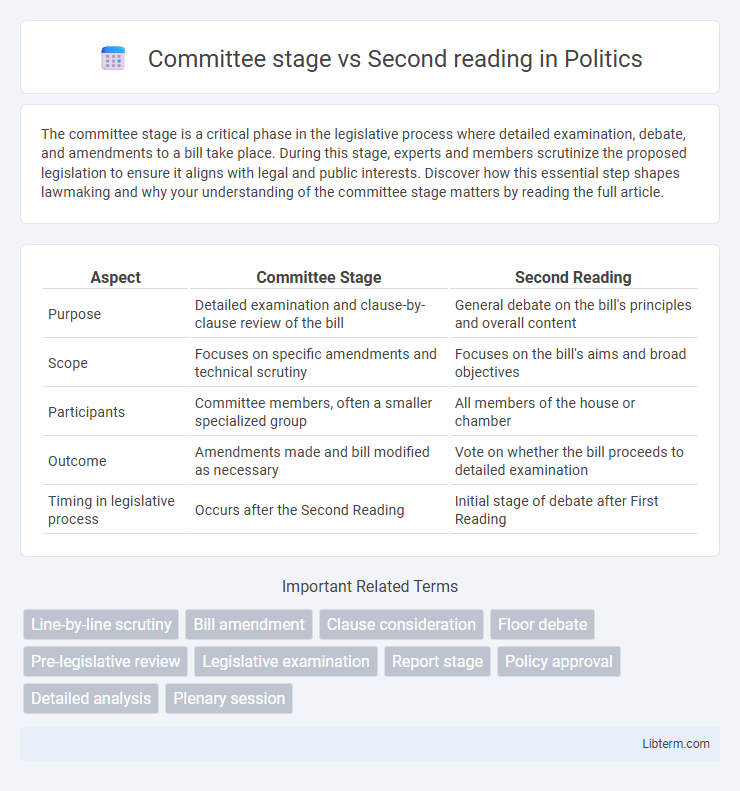The committee stage is a critical phase in the legislative process where detailed examination, debate, and amendments to a bill take place. During this stage, experts and members scrutinize the proposed legislation to ensure it aligns with legal and public interests. Discover how this essential step shapes lawmaking and why your understanding of the committee stage matters by reading the full article.
Table of Comparison
| Aspect | Committee Stage | Second Reading |
|---|---|---|
| Purpose | Detailed examination and clause-by-clause review of the bill | General debate on the bill's principles and overall content |
| Scope | Focuses on specific amendments and technical scrutiny | Focuses on the bill's aims and broad objectives |
| Participants | Committee members, often a smaller specialized group | All members of the house or chamber |
| Outcome | Amendments made and bill modified as necessary | Vote on whether the bill proceeds to detailed examination |
| Timing in legislative process | Occurs after the Second Reading | Initial stage of debate after First Reading |
Introduction to Legislative Stages
The Committee stage involves detailed examination, debate, and amendment of a bill by a designated group of legislators, allowing for scrutiny clause by clause. The Second Reading marks the first formal opportunity for the entire legislative body to debate the general principles and purpose of the bill before it proceeds to more detailed consideration. Understanding these stages is essential for navigating the legislative process and tracking the bill's progress toward becoming law.
Overview of the Second Reading
The Second Reading marks a critical phase in the legislative process where the general principles and overall purpose of the bill are debated and voted on, determining whether it proceeds further. This stage focuses on the broad merits of the legislation rather than detailed examination, which occurs during the Committee stage. Success in the Second Reading signifies parliamentary approval of the bill's intent, allowing it to move forward to detailed scrutiny and potential amendments.
Key Objectives of the Second Reading
The Second Reading primarily aims to debate the general principles and overall intent of the bill, allowing members to express support or opposition based on its core objectives. It serves as a crucial stage for assessing the bill's purpose before detailed examination, ensuring that the legislation aligns with legal and policy frameworks. Unlike the Committee stage, which focuses on clause-by-clause scrutiny and amendments, the Second Reading emphasizes the bill's foundational goals and parliamentary approval of its principle.
Committee Stage Explained
The Committee Stage is a detailed examination phase in the legislative process where each clause of the bill is reviewed, debated, and amended by committee members, ensuring thorough scrutiny of its provisions. Unlike the Second Reading, which focuses on the general principles and overall purpose of the bill, the Committee Stage allows for specific and technical modifications to improve the legislation. This stage often involves evidence gathering, expert testimony, and line-by-line analysis, helping to refine the bill before it returns for further readings and eventual voting.
Functions of the Committee Stage
The Committee Stage plays a crucial role in the legislative process by allowing detailed examination, debate, and amendment of the bill's provisions. Unlike the Second Reading, which focuses on the general principles and overall purpose of the bill, the Committee Stage provides an opportunity to scrutinize specific clauses line-by-line. This stage enhances the quality of legislation by involving specialized committees, ensuring that technical details and potential implications are thoroughly assessed before the bill progresses.
Main Differences Between Second Reading and Committee Stage
The Second Reading focuses on the general principles and overall purpose of a bill, allowing members to debate its main ideas without detailed amendments. The Committee Stage delves into a line-by-line examination, where members can propose, discuss, and vote on specific changes to the bill's content. Unlike the Second Reading, the Committee Stage enables detailed scrutiny and modification of the bill before it proceeds to further consideration.
Importance of the Second Reading in Lawmaking
The Second Reading is a critical phase in lawmaking where the general principles and purpose of a bill are debated and voted on, determining whether it should proceed to detailed examination. Unlike the Committee Stage, which scrutinizes specific clauses and technical details, the Second Reading establishes the legislative intent and political consensus necessary for further consideration. Successful passage at this stage signifies parliamentary approval of the bill's core objectives, enabling it to advance toward becoming law.
Impact of Committee Stage on Legislation
The Committee Stage allows detailed examination and amendment of a bill, refining its provisions to address issues raised during the Second Reading. Unlike the Second Reading, which focuses on the general principles and overall approval of the legislation, the Committee Stage provides a critical opportunity for lawmakers to scrutinize the bill's specifics, improving clarity and effectiveness. This process significantly impacts legislation by ensuring that technical flaws are corrected and diverse viewpoints are incorporated before the bill proceeds to further readings.
Advantages and Limitations of Each Stage
The Committee stage allows detailed examination and amendment of a bill, enabling members to scrutinize specific clauses thoroughly, which enhances legislative precision but can be time-consuming and delay progress. The Second Reading offers an opportunity to debate the general principles, facilitating a broad consensus on the bill's purpose while limiting detailed discussions, which may overlook finer issues. Combining both stages balances comprehensive review with efficient legislative progression, though it requires managing the trade-offs between depth and speed.
Conclusion: Comparing Committee Stage and Second Reading
The Committee Stage involves detailed examination, debate, and amendment of a bill, offering an in-depth review by selected members. The Second Reading serves as a general debate on the bill's principles and overall purpose without detailed amendment. Comparing both, the Committee Stage is crucial for refining legislative content, while the Second Reading tests the broader parliamentary support for the bill's fundamental objectives.
Committee stage Infographic

 libterm.com
libterm.com